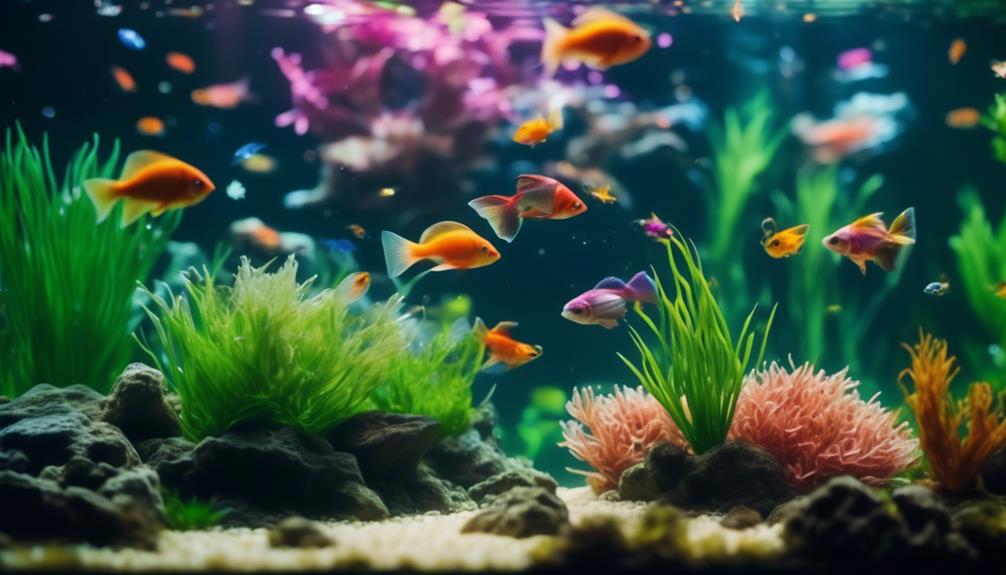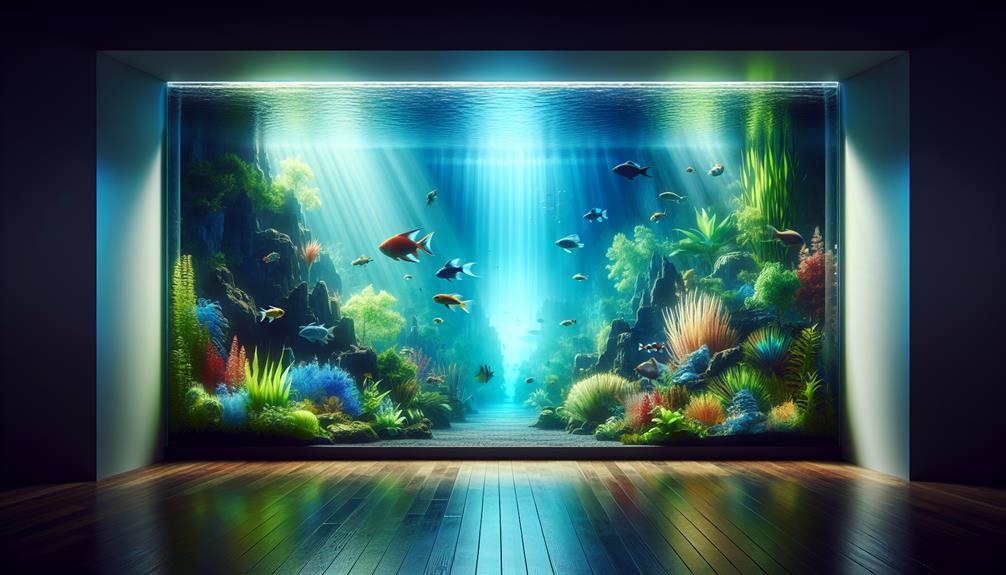Welcome to the fascinating world of aquarium maintenance, where the secrets to achieving crystal clear aquariums lie.
As any fish enthusiast knows, maintaining a visually stunning aquarium can be a challenging task. Cloudy water not only diminishes the beauty of your aquatic display but also serves as a potential indicator of underlying issues.
In this article, we will uncover the causes of cloudy water, ranging from fish waste to free-floating algae, and explore effective cleaning techniques.
But that's not all – we will also venture into the realm of bacterial blooms, green water, and brown water, revealing the methods to tackle these challenges head-on.
So, join us as we embark on this journey of discovery, unraveling the secrets that will transform your aquarium into a crystal clear haven for your beloved aquatic companions.
Key Takeaways
- Regular tank maintenance, including cleaning the substrate, changing the water, and cleaning the filter, is essential for preventing cloudy water in aquariums.
- Overfeeding the fish and allowing excessive debris to accumulate can lead to cloudy water, so it's important to feed cleaner foods and avoid neglecting tank maintenance.
- Understanding the importance of beneficial bacteria and the aquarium nitrogen cycle is crucial for maintaining water clarity and preventing bacterial blooms.
- Green water can be cleared by addressing excessive light and nutrient levels, considering the use of a UV sterilizer for algae control, and performing multiple water changes. Brown water can be removed by gradual water changes, soaking driftwood before adding it to the tank, and using activated carbon in the aquarium filter.
Causes of Cloudy Water
Cloudy water in aquariums can be caused by various factors, including fish waste, excess food, dusty substrate, and other debris.
Prevention methods for cloudy water include setting up a regular tank maintenance schedule, using an aquarium siphon to vacuum the substrate and change the water, cleaning the filter monthly, and feeding cleaner foods to minimize dusty fish poop.
Common mistakes that cause cloudy water include neglecting regular tank maintenance, overfeeding the fish, and allowing excessive debris to accumulate in the aquarium.
To maintain crystal clear water, it is essential to scrub the inside of the tank with an algae scraper, clean the outside of the tank using an aquarium-safe cleaner, and learn about beneficial bacteria and the aquarium nitrogen cycle.
Maintenance and Cleaning Tips
To maintain optimal water clarity in your aquarium, it is crucial to establish a regular maintenance and cleaning routine. This includes proper substrate care and the importance of regular water changes. By following these guidelines, you can ensure a clean and healthy aquatic environment for your fish.
Firstly, proper substrate care involves regular vacuuming to remove fish waste, excess food, and other debris. This can be done using an aquarium siphon, which helps to keep the substrate clean and free from buildup. Additionally, feeding cleaner foods can minimize dusty fish poop, reducing the amount of waste that accumulates in the substrate.
Secondly, regular water changes are essential for maintaining water clarity. This helps to remove excess nutrients and replenish beneficial bacteria, which play a crucial role in the aquarium's ecosystem. By performing regular water changes, you can prevent the buildup of harmful substances and maintain a stable water chemistry.
Lastly, cleaning the filter monthly is important to ensure its efficiency. This involves removing any debris and rinsing the filter media to maintain proper water flow and filtration.
Dealing With Bacterial Bloom

Bacterial blooms in aquariums can occur during the cycling process or after the addition of a large number of fish. Dealing with bacterial bloom requires understanding the role of beneficial bacteria and taking preventive measures.
Here are some tips to help you prevent and manage bacterial bloom in your aquarium:
- Ensure proper aquarium cycling by allowing beneficial bacteria to establish before adding fish.
- Avoid adding a UV sterilizer or excessive water changes, as they can disrupt the balance of beneficial bacteria.
- Wait for one to two weeks for the bloom to clear up on its own, as bacterial blooms often resolve naturally.
- Maintain good water quality by regularly testing and monitoring parameters such as ammonia, nitrite, and nitrate levels.
- Consider using a biological filter supplement to boost the population of beneficial bacteria and promote a stable aquarium environment.
Clearing Green Water
Excessive light and nutrient levels contribute to the formation of green water in aquariums. Algae blooms can quickly turn the water in your tank from clear to murky green.
To combat this issue, consider using a UV sterilizer for algae control. UV sterilizers emit ultraviolet light that kills algae cells, preventing them from reproducing and causing the water to turn green.
However, it's important to note that UV sterilizers may also kill beneficial bacteria in the aquarium. Beneficial bacteria play a crucial role in maintaining water quality by breaking down harmful toxins.
Therefore, after using a UV sterilizer, it is recommended to perform multiple water changes to remove dead algae and replenish the beneficial bacteria population.
Removing Brown Water

One effective method for removing brown water from your aquarium is through gradual water changes. This process involves replacing a portion of the tank water with fresh, clean water over time.
In addition to this method, there are a few other techniques you can try to eliminate the brown tint in your aquarium:
- Soaking driftwood: If the brown water is caused by tannins released from driftwood, you can soak the wood in a separate container before adding it to the tank. This will help to leach out some of the tannins and reduce their impact on the water.
- Using activated carbon: Activated carbon is a highly porous substance that can effectively absorb organic compounds, including tannins. By placing activated carbon in your aquarium filter, you can help to remove the brown coloration from the water.
Frequently Asked Questions
How Long Does It Typically Take for a Bacterial Bloom to Clear up on Its Own?
The duration for a bacterial bloom to self-clear in an aquarium varies, typically ranging from one to two weeks. Factors such as aquarium cycling and fish additions can trigger these blooms, and it is advisable to avoid excessive water changes and the use of UV sterilizers.
Can I Use Household Cleaners to Clean the Inside of My Fish Tank?
Using household cleaners to clean the inside of a fish tank is not recommended. It is important to use aquarium-safe cleaners and follow proper aquarium cleaning methods to maintain a clean and healthy environment for your fish. Regular water changes and proper filtration are key in maintaining water quality and preventing bacterial blooms.
What Are Some Signs That My Aquarium Has Excess Nutrients?
Signs of excess nutrients in an aquarium include cloudy water, excessive algae growth, and foul odors. To address this, regular aquarium maintenance and nutrient control are key. Proper filtration, water changes, and balanced feeding can help maintain a healthy aquarium ecosystem.
Can I Use Regular Tap Water for Water Changes, or Do I Need to Treat It First?
Regular tap water should be treated before using it for water changes in an aquarium. Water treatment is important to remove harmful chemicals such as chlorine and heavy metals, ensuring the health and well-being of the aquatic life.
How Often Should I Clean the Filter in My Aquarium?
The filter in your aquarium serves as the unsung hero, tirelessly removing impurities and maintaining water quality. Cleaning frequency depends on the filter type and tank size, but a general rule is monthly maintenance to ensure optimal performance and a healthy aquatic ecosystem.
Conclusion
In conclusion, maintaining a crystal clear aquarium requires diligent maintenance and cleaning techniques to address the various causes of cloudy water. By understanding the importance of regular tank maintenance schedules, substrate vacuuming, filter cleaning, and tank wall scrubbing, fish enthusiasts can create a visually appealing and healthy environment for their aquatic companions.
Additionally, dealing with bacterial blooms during aquarium cycling and implementing methods to clear green and brown water will further enhance the clarity and aesthetics of the aquarium.
Achieving a crystal clear aquarium is like creating a masterpiece, where every element harmoniously comes together to create a visually stunning and thriving aquatic ecosystem.

